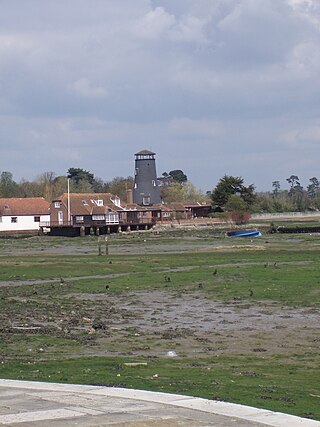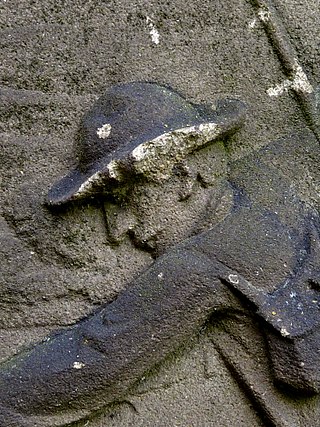
Horning is an ancient village and parish in the English county of Norfolk. It covers an area of 11 km2 and had a population of approximately 1,100 in the 2021 census. Horning parish lies on the northern bank of the River Bure south of the River Thurne and is located in The Broads National Park. For the purposes of local government, it falls within the district of North Norfolk, although areas alongside the rivers and broads fall into the executive area of the Broads Authority.

Potter Heigham is a village and civil parish on the River Thurne in the English county of Norfolk. It is situated 12 mi (19 km) north-east of the city of Norwich on the A149 road, and within the Broads National Park.

Ludham is a village and civil parish in the English county of Norfolk, in the Norfolk Broads, at the end of a dyke leading to Womack Water and flowing into the River Thurne. It lies 1.5 miles (2.4 km) to the East of Ludham Bridge, which is on the River Ant. It covers an area of 12.18 km2 (4.70 sq mi) and had a population of 1,301 in 582 households at the 2001 census, the population reducing to 1,278 at the 2011 census. For the purposes of local government, it falls within the district of North Norfolk.

Samuel Bamford was an English radical reformer and writer born in Middleton, Lancashire. He wrote on the subject of northern English dialect and wrote some of his better known verse in it.

Flora Caroline Twort was an English painter who specialised in watercolours and pastels of the scenes and people of Petersfield, Hampshire.

East Anglian English is a dialect of English spoken in East Anglia, primarily in or before the mid-20th century. East Anglian English has had a very considerable input into modern Estuary English. However, it has received little attention from the media and is not easily recognised by people from other parts of the United Kingdom. The dialect's boundaries are not uniformly agreed upon; for instance, the Fens were traditionally an uninhabited area that was difficult to cross, so there was little dialect contact between the two sides of the Fens leading to certain internal distinctions within that region.
Welburn is a village and civil parish in North Yorkshire, in England, 2 miles south-west of Kirkbymoorside and about 24 miles from York. The population of the parish was estimated at 60 in 2012. As the population of the civil parish was less than 100 it was not separately counted in the 2011 census and was included with the civil parish of Wombleton.
Harry Fred Cox, was a Norfolk farmworker and one of the most important singers of traditional English music of the twentieth century, on account of his large repertoire and fine singing style.

Sir Clement Higham MP JP PC of Barrow, Suffolk, was an English lawyer and politician, a Speaker of the House of Commons in 1554, and Chief Baron of the Exchequer in 1558–1559. A loyal Roman Catholic, he held various offices and commissions under Queen Mary, and was knighted in 1555 by King Philip, but withdrew from politics after the succession of Queen Elizabeth I in 1558.
Sir Bysshe Shelley, 1st Baronet, was the grandfather of English Romantic poet Percy Bysshe Shelley.
Peter Felix Richards (1808–1868) was a pioneering Scottish merchant in Shanghai in the era following the Treaty of Nanjing. He founded the Richards Hotel and Restaurant, the first foreign hotel in China, and the forerunner to the Astor House Hotel.

Sir Edward Lewknor or Lewkenor was a prominent member of the puritan gentry in East Anglia in the later Elizabethan period, and an important voice on religious matters in the English Parliament.

Matthew Taylor was a sculptor based in Leeds and Arthington, West Yorkshire, England. He was apprenticed to Catherine Mawer, and was known in his day for bust, medallion and relief portraits, and statues. He exhibited some of these in Leeds Art Gallery during the last decade of his life. Between 1861 and 1876 he worked in partnership with Benjamin Burstall (1835–1876); they executed the sculpture on the Town Hall at Bolton in Greater Manchester. After Taylor's death, in 1905 his work received further recognition when Reverend W.T. Adey praised his carving on William Taylor's gravestone at Woodhouse Cemetery, Leeds, and named it the "Angler's Tomb." That work is now a listed monument. Taylor was a member of the Mawer Group, which included the above-mentioned sculptors, plus Robert Mawer, Charles Mawer, Benjamin Payler and William Ingle.
Duncan Hall School was a boys’ prep school at Scratby Hall in Ormesby St Margaret with Scratby, Norfolk from 1949 to 1986, with girls admitted from 1979. Prior to occupying Scratby Hall, it was located in Great Yarmouth and was called Duncan House.

Francis Rugge, of Norwich, Norfolk, was an English politician.

Bracondale School was a private boys' school in the Bracondale area of Norwich, Norfolk. It existed from 1821 to 1993.

St Margaret's Church is the parish church of Hopton-on-Sea in the English county of Norfolk. It is dedicated to St Margaret of Antioch. St Margaret is also the dedication of the former church, which was destroyed by fire in 1865. The ruins of the former church remain standing, and are still consecrated. Both the old and new churches are Grade II* listed. Until 1974, Hopton-on-Sea was called Hopton ; the formal name for the benefice remains Hopton. The church is in the Diocese of Norwich, and is within the deanery of Lothingland and archdeaconry of Norfolk.

Sir Peter Seaman (1662–1715), Knight Batchelor, of the City of Norwich in Norfolk, England, was a brewer who served as Mayor of Norwich 1707-8, Colonel of the City Corps and High Sheriff of Norfolk in 1710.
Henry Woodcock, Esq. (1789–1879) was a prominent 19th century public official in the city of Norwich, Norfolk, United Kingdom. He was elected Sheriff of Norwich for one term (1839), and Mayor of Norwich for two terms and served as commissioner and magistrate.















